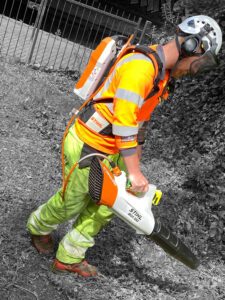HAVS
HAVS: ‘Real-time monitoring and measurement should be mandated in the regulations’
The Health & Safety Executive will fine companies that expose workers to hazardous excessive levels of vibrations. Yet the organisation’s own guidance doesn’t require businesses to continually monitor workers. Russ Langthorne of HAVSPRO considers why it’s time for real-time monitoring and measurement to be mandated in the regulations.
All shook up – is it time to revisit the regulations on vibration?
 “Prolonged exposure to vibration can have a significant, harmful and permanent impact on worker health. There is absolutely no doubt about this. The science is understood, the effects are all too visible on those who suffer, and the fines imposed on negligent companies are appropriately stringent, not to mention to compensation claims they have to face.
“Prolonged exposure to vibration can have a significant, harmful and permanent impact on worker health. There is absolutely no doubt about this. The science is understood, the effects are all too visible on those who suffer, and the fines imposed on negligent companies are appropriately stringent, not to mention to compensation claims they have to face.
“Nonetheless, when it comes to solving the issue, there remains extensive debate on how best to help businesses protect their employees and, by doing so, themselves.
“The essential advice contained within the Control of Vibration at Work Regulations 2005 (aka L140) has not changed substantially since its original publication, even in the second edition, dated 2019. As expressed by Health & Safety Executive inspectors, “The ONLY way to substantially reduce the risk of somebody developing vibration related ill-health is to ELIMINATE or significantly REDUCE their EXPOSURE to vibration.”
“At first glance, this is common sense, but anybody who works with vibrating equipment will quickly want to know: what happens when elimination isn’t possible? And what counts as a significant reduction?
“Elimination of exposure to vibration is a laudable goal, but it’s impractical without widespread automation – and the level of investment required to achieve it is beyond most organisations. In my practical experience, in many industries a degree of vibration is unavoidable. As a result, there still needs to be a mechanism for understanding the severity of the exposure, whenever it occurs.
“Likewise, reduction is a sensible aspiration, but again it’s something that requires a degree of thought and factual information to do properly – and that requires accurate, empirical data, in order to understand when and when action is required.
“In these circumstances, businesses need a practical means of keeping workers safe. We should all strive to eliminate vibration, but where it exists, continual monitoring is a must.
“Unfortunately, the HSE sees it a different way.”
The case against monitoring
“The Regulations don’t have much to say on the subject of monitoring; in fact, the relevant advice is contained in just two paragraphs, nos. 148 and 149.”
The key passages to consider are:
‘148 – If it helps you to do your risk assessment, a period of monitoring with these devices to understand how long employees use a particular machine in a typical day or week may be useful. However, once you have enough information on likely exposure, your focus should move to taking practical steps to reduce the exposure and risks.’
‘149 – There is no legal requirement under the Vibration Regulations for continual monitoring and recording of vibration exposure. Using logbooks and tool-timers, and continual monitoring, can distract you from your duties to eliminate or reduce vibration risks.’
“In other words, monitoring is seen as being a hindrance to the work of eliminating or reducing vibration. When the regulations were written, there was an argument that monitoring was too costly, time-consuming and unreliable to undertake continually – but in 2022, the technology exists to render this argument null and void. Modern vibration monitoring is automated, cost-efficient and accurate, offering a permanent, real-time risk assessment to avoid harm before it happens.
“If you don’t continually monitor, how can you be confident you have acted in the best way for your staff and the company?”
The case for monitoring

“Since the initial publication of these Regulations in 2005, so much has changed in terms of the technological capabilities and user benefits of monitoring technology, that, in my opinion, the case for monitoring far outweighs this, outdated view.
“There are several key reasons why mandating continual monitoring will not only protect workers on a daily basis, but actually enable businesses to focus on the longer-term elimination of exposure.
“Firstly, the data on which the HSE suggests running a short-term risk assessment is flawed. It relies on taking the technical specification of a tool as outlined by the manufacturer and applying this data against the HSE’s own ‘ready reckoner’ – a table for determining the Exposure Action Value (EAV) and Exposure Limit Value (ELV) for that tool.
“The biggest problem with this approach is that the manufacturer’s data will typically be acquired under laboratory conditions, giving no insight into the variations caused by the specific job being worked on, the condition of the tool, the consumables being used, or how the operator is using it. Continual monitoring, on the other hand, enables real-time decision-making based on the real-world environment – and, potentially, provides the data required to take informed action to reduce vibrations (for example, by replacing a blunt consumable).
“Secondly, the daily values associated with vibration risk – EAV and ELV – are cumulative. This makes the calculations made from the ready reckoner, time-consuming to aggregate and open to errors, if an operative uses more than one tool in a shift. Instantly, a lot more work is required to calculate the EAV and ELV and, as pointed out above, it still might not be accurate and it’s also retrospective, meaning the opportunity to act before any damage is done has passed.
“Continual monitoring, especially as practiced by HAVSPRO, avoids this issue, by attaching the operator’s sensor onto whatever tool they are using. Each time an individual operator uses a specific tool, they simply click the sensor onto the tool – and then, when finished, they take it with them and click it onto the next tool, and so on.
“As a result, employers receive accurate, real-time data, linked to the personalised profile of the user, delivering tangible, accurate, meaningful and relevant data to inform a risk assessment. Because the sensor data is recorded to the cloud via an on-site beacon, employers can act instantly to reduce exposure.
“Better still, over time this data will form a detailed picture of the biggest risks on-site, enabling employers to prioritise where to invest in eliminating the vibration risk to workers.”
Belt and braces
“HSE training makes a comparison between vibration monitoring and a thermometer in an office. Just because you know how warm the office is, doesn’t mean you’ve solved the problem and know when it’s too hot. You need to (for example) open the window to take action to cool the room down.
“The trouble is that, without the thermometer, will people know when to open the window? In my experience, if businesses don’t act, that’s because they don’t realise when there’s a problem. Given the ability to ‘take the temperature’ of vibration levels on a continual basis, they will undoubtedly act to reduce (and, where possible, eliminate) exposure.
“So, here’s my proposal. The regulations need an amendment, to take a more nuanced view of the benefits that monitoring brings. This doesn’t mean overruling the general advice: elimination and reduction are obviously the best solutions. Yet adding monitoring as a mandatory requirement is also a practical, effective way to protect workers.
“At HAVSPRO, we’re happy to work alongside the HSE and other monitoring providers to facilitate this amendment. Scientifically, operationally and ethically, it makes sense, to take a ‘belt and braces’ approach, to offer the thermometer as well as the open window. When it comes to the safety of your workforce, if there is more that we can do, we should do it, and do it now.”
HAVS: ‘Real-time monitoring and measurement should be mandated in the regulations’
The Health & Safety Executive will fine companies that expose workers to hazardous excessive levels of vibrations. Yet the organisation’s own guidance doesn’t require businesses to continually monitor workers. Russ Langthorne of HAVSPRO considers why it’s time for real-time monitoring and measurement to be mandated in the regulations.
Safety & Health Practitioner
SHP - Health and Safety News, Legislation, PPE, CPD and Resources Related Topics
Company fined £360k after trapped worker loses life
Company fined after worker crushed to death
Horticulture company fined after lorry driver suffers life changing injuries

 “Prolonged exposure to
“Prolonged exposure to 
This is just a sales pitch – if you really wanted to solve the problem you would reduce the cost of the product to make it more accessible
Also there-in lies the problem, real-time monitoring is only as the person carrying out the monitoring.
One flaw in the “pitch” is that the operator switches on the on-tool monitoring device, therefore giving the false reading, the operator can use the tool for a time and then choose to switch the monitoring device for another spell then turn it off, surely a better monitoring method would be, If the monitor be activated when the trigger or tool is initially operated/used?
This is just an advert for those involved with HAVs monitoring, the law states you must carryout a suitable risk assessment, record the findings and reduce the risks as necessary. Just the same as with exposure to noise at work, monitoring not required there by law also.
Actually I do know when to open a window; based on how I feel, not what a thermometer might say. That comparison doesn’t work.